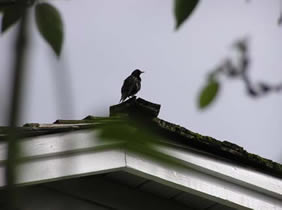

NATURE NOTES

European Starling, photo by Hugh Griffith
For the Love of Shakespeare
by
The above photograph is of one of the commonest North American birds, which you may have witnessed wrestling with a cold french fry in a parking lot. It has the telling scientific name, Sturnus vulgaris.
It is the European Starling, imported from England by way of New York City. Why? Because Shakespeare mentioned it. In Henry IV, Hotspur declares, "I'll have a starling taught to say nothing but 'Mortimer,' and I'll give it to him to keep his anger still in motion." If you haven't read the play (me neither) the line out of context makes little sense.
For his love of Shakespeare and a desire to introduce into North America all birds mentioned by the Bard, a theatre fan named Eugene Schieffelin released 60 starlings into Central Park in 1890, and 40 more the following year. He was dropping a biological dirty bomb.
The starling spread rapidly. It is the most common bird in many North American cities and, perhaps, the least liked after the pigeon. Count me among its detractors. Its successful colonization is due to its adaptability and hardiness as well as availability of small cavities in urban landscapes where it can nest. The starling reached Vancouver in the 1930s.
It is a small, dark, short-tailed bird. Breeding adults have yellow bills, iridescent feathers that shine purple and green and are flecked with white spots. In non-breeding season, starlings form large flocks capable of much noise and, well, let's just say you don't want to park your car under one of their roosts. On the ground, they walk, nay, swagger, rather than hop as do robins and other urban birds. In a few weeks you will see the brown-feathered young harassing their exhausted parents with their persistent begging cries, which sound remarkably close to "Feed me!"
The starling has often been cited as an aggressive competitor to native cavity-nesting birds such as bluebirds and woodpeckers and has been held responsible for the decline of these species. However, this has not been shown conclusively. Habitat loss or fragmentation here and in the southern wintering grounds of migrant species is perhaps a stronger explanation for the reduction in native bird populations.
The starling possesses at least one interesting feature. As a member of the mynah family, it is a skilled mimic. The usual song is a cacophony of gargles, chitters and squawks. However, it can mimic many other birds and reproduce a variety of non-avian sounds, including bells, whistles and telephones. Be very afraid should they be exposed to the ring-tones of the newest generation cell phones. Some starlings have also been taught to speak.
The bird pictured was on my neighbour's roof. It was giving the usual starling gibberish when he caught my attention with a sudden perfect rendition of the shrill babbling cry of a bald eagle. He went back to starling for a bit, but then emitted the piercing call of a red-tailed hawk. Next he let loose with the melodious song of the goldfinch and followed this closely with the "whew, whew, whew," of the greater yellowlegs, a migratory wading bird.
I was impressed and am now conflicted. I never liked starlings and have always considered them unattractive, invasive pests. After a little reading though, I question their supposed impact on native species. The more you learn, the more confusing things get. Sing on bird. Say "Mortimer."
Hugh Griffith is a BC zoologist and science writer.
Please cite these pages as:
Author, date, page title. In: Klinkenberg, Brian. (Editor) 2023. E-Fauna BC: Electronic Atlas of the Fauna of British Columbia [www.efauna.bc.ca]. Department of Geography, University of British Columbia, Vancouver. [Date Accessed]
© Copyright 2023 E-Fauna BC.